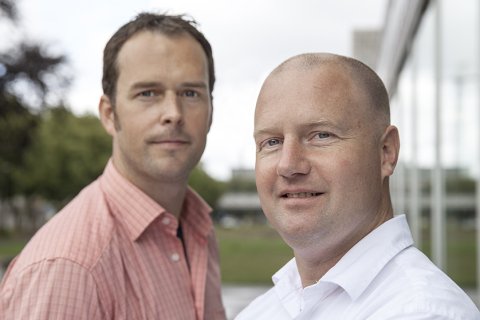To a new therapy against liver diseases
Life Sciences

An end to liver transplants - that is the dream of researchers Bart Spee and Niels Geijsen. The pair seek to produce healthy liver cells from the body’s own cells, such as skin cells, to hopefully cure liver diseases. They hope to get their first results with the contribution from first call Seed Money for Life Sciences.
Serious liver diseases, such as cirrhosis or Wilson’s disease, are often untreatable. Transplants are the only option in many cases for human patients, but there is a waiting list for donors. This will not be an option for pets, who therefore have to be euthanized. “Around 5,000 dogs are brought to our clinic every year, 250 of which have liver conditions,” says Bart Spee, an Assistant Professor at the Faculty of Veterinary Medicine. “They often have chronic liver infections, because their bile excretes less copper - similar to Wilson’s disease in people.”
For this reason, Spee is researching new methods for treating liver diseases. He is producing liver cells in a laboratory from stem cells taken from dogs and humans, from which essentially any type of cell can be made. “That is proving to be very difficult,” Spee says. The cells we have produced so far with this method turn out to not possess all the functions of adult liver cells.”
Stem cells no longer needed
Spee’s work ties in closely with that of Niels Geijsen, a Professor at the Hubrecht Institute and the Faculty of Veterinary Medicine, who is carrying out fundamental research into the re-programming of stem cells. Together, they modified the technique so that the stem-cell phase can be eliminated. “A skin cell, for example, can be converted directly into a liver cell,” says Geijsen. “With this technique, in combination with new substances that help bring the liver cells to maturity, we eventually get cells that possess all the functions of the liver.”
“We are using the seed money to get our first results,” Spee says. “These results may help strengthen subsequent applications for grants. It is important to create momentum.” Geijsen adds, “This grant can help turn an attractive idea into something concrete, so that other parties will see its value. That is how the project can really take off.”
Smaller step to human use
Geijsen and Spee’s first goal is to develop new therapies and to apply them to dogs. “But it may be possible to apply them to humans as well,” says Geijsen. “Canine patients are much more similar to humans than mice are, to name an example. It means that it will be a smaller step to apply them to humans. It would be wonderful if waiting times for liver transplants would ultimately disappear.”
Utrecht
“The presence of various disciplines is also a major advantage of the Utrecht Science Park,” Geijsen continues. “The fundamental research departments of the Hubrecht Institute and clinical practices of the Faculty of Veterinary Medicine and the UMC Utrecht are all located within the same square kilometre. This is unique in the world. It makes it very easy to meet up.”
Less animal testing
In addition to a possible new treatment of liver diseases, the researchers see other potential applications. “Studies into the toxicity of substances currently involve animals,” Geijsen says. “But once we are able to produce liver cells, it will be possible to simply test these substances in a Petri dish and require less animal testing.”
Jos van Putten, Life Sciences Programme Director at Utrecht University, says: “The research carried out by Bart Spee and Niels Geijsen is a fine example of fundamental and translational research that can be broadly applied in a range of fields. It has an excellent chance of receiving further funding and is of great value to many other ongoing research projects at Utrecht Science Park.”
Text: Roy Keeris

